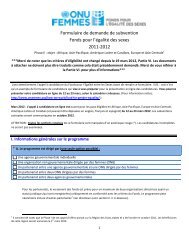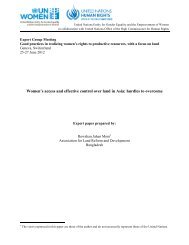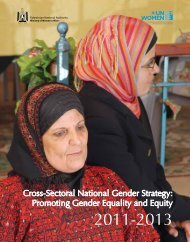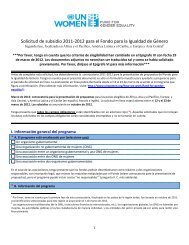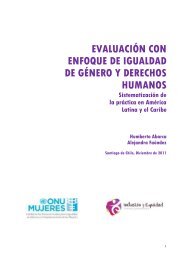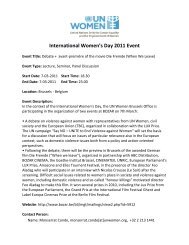Informal Justice Systems: Charting a Course for Human - UN Women
Informal Justice Systems: Charting a Course for Human - UN Women
Informal Justice Systems: Charting a Course for Human - UN Women
You also want an ePaper? Increase the reach of your titles
YUMPU automatically turns print PDFs into web optimized ePapers that Google loves.
sUMMarY<br />
26<br />
boX 14. monitoring<br />
by ngos<br />
unless it is developed in careful<br />
dialogue with ijs and the community,<br />
outside monitoring may be seen<br />
as an unwelcome intrusion into a<br />
traditional structure. in Bangladesh<br />
and malawi, ngos were able to gain<br />
access to traditional ijs by providing<br />
support and obtaining the trust of the<br />
leaders and communities.<br />
boX 15. pubLic hearings in bangLadesh<br />
Public hearings can be an effective way to promote en<strong>for</strong>cement<br />
of ijs decisions, including through ensuring publicity<br />
<strong>for</strong> the hearings. the Shalish courts in Bangladesh use a<br />
highly public <strong>for</strong>um <strong>for</strong> decision-making and publicizing<br />
case outcomes. the recording of the decision takes place<br />
in the minds of community members rather than on paper<br />
and the collective conscience of the community is committed<br />
to en<strong>for</strong>cement.<br />
Parajudicial systems generally have regulations providing <strong>for</strong> an<br />
official inspection and supervision framework, but they are often<br />
ineffective because supervisory organs lack resources. in some<br />
countries, supervision of parajudicial systems is also difficult because<br />
of unclear and overlapping supervisory mandates and the various<br />
monitoring frameworks are sometimes not coordinated with one<br />
another. supervision by executive agencies also raises issues of the<br />
independence of the judiciary. monitoring should take its point of<br />
departure in the mutually supportive role of ijs and (other) organs<br />
of the state. it should thus af<strong>for</strong>d providers with an opportunity to<br />
voice their concerns. a monitoring system that is purely top-down<br />
and seen by the ijs’ providers as an instrument that only serves to<br />
criticize them is unlikely to be successful.<br />
requirements of public hearings and open<br />
admission to the court or adjudication <strong>for</strong>um,<br />
including <strong>for</strong> the general public and observers<br />
from civil society organizations and the<br />
media, provide clear transparency measures.<br />
Where recording of decisions is not possible<br />
(perhaps due to literacy levels) or not<br />
accepted in ijs, public hearings can provide an<br />
accountability and transparency mechanism<br />
between ijs and the community. community<br />
groups, such as grassroots women’s groups,<br />
can develop their own records of the proceedings and monitor the pattern of the decisions as well as procedures<br />
followed in ijs. although not appropriate <strong>for</strong> sensitive cases (possibly where children are involved), public hearings<br />
can also strengthen the likelihood of en<strong>for</strong>cement of ijs’ decisions, as such decisions will be more widely<br />
known and there<strong>for</strong>e accepted in the community. a further step would be to involve community groups in the<br />
decision-making; this could be done through consultation or jury-type assemblies. such mechanisms could allow<br />
<strong>for</strong> women’s participation, particularly where women are not represented among ijs’ adjudicators.<br />
monitoring and oversight often require record keeping (and thus literacy) among providers and a clear structure<br />
that takes account of a set of standards (structural, procedural and normative) against which ijs are to be assessed.<br />
ijs providers may be working <strong>for</strong> no or very little compensation, and the imposition of additional work burdens<br />
may be unwelcome or unrealistic. adjudicators and monitors may need to be trained in the reporting and monitoring<br />
methodology. these interventions can be costly and must be weighed against the benefits of using similar<br />
resources <strong>for</strong> other institutions.<br />
7. Linkages among primary <strong>Justice</strong> providers<br />
ijs should be seen as operating in conjunction with other avenues of primary justice. in many contexts, there could<br />
be several kinds of ijs operating in addition to <strong>for</strong>mal systems. the numerous linkages in many countries between<br />
different primary justice providers, be they functional or norm-/rule-based, official or unofficial, ultimately challenge<br />
any notion of entirely separate and distinct legal systems. the propriety of programming aimed at better<br />
alignment between <strong>for</strong>mal and in<strong>for</strong>mal systems will depend on the context of national justice policy, the jurisdictional<br />
division between <strong>for</strong>mal and ijs, and an analysis of the desired and factual links between the two. in certain<br />
circumstances, the value of promoting linkages will consist of fostering better understanding between the systems<br />
and allowing <strong>for</strong> a discussion about division of labour, respective jurisdictions and better mechanisms <strong>for</strong> referral.<br />
a stuDy of in<strong>for</strong>mal justice systems: access to justice anD human rights



